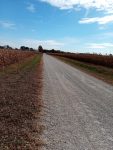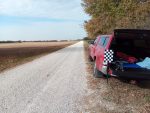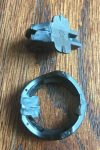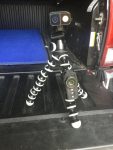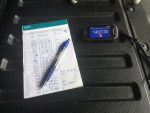When people talk about working remotely they usually mean working from home. Over the past weekend I had to really work remotely:
I was recording finishing times for competitors in the 2020 Ill Kanza Gravel Fondo bike event. Ill Kanza is an event my cycling team runs each year and is held about an hour south of Champaign in the town of Kansas (IL). I try to volunteer for at least one event a year. This year they did not have the cyclocross race I usually volunteer for so here I was at the gravel fondo.
This was the first time I would be working a finish line for a race and I was not sure what to expect. I had to get it right relatively quickly (within a few minutes) because all the participants were paying money, putting forth this incredible effort and it would be unfair for me to screw it up after several hours of riding. We also had the issue, because of COVID-19, that there were not many volunteers. I think there were just 4 of us (Neil, Scott, Mark and myself). Mark and Scott were only working for part of the time: Scott was racing and Mark had to get back to town for other commitments. This meant I was the only person at the finish and I should be there for the entire time (until roughly 5 PM).
Timing an event
I learned through Neil that all I really needed was an accurate timing device, pen and paper and possibly a way to update a Google spreadsheet. He also said that having a camera might help as well. I could do that!
Neil asked me to get to the finish line by around 10:15 AM. One thing I failed to ask was if I should be ready to record riders or start setting up at that time. I planned on being ready to record riders by that time, stopping by the registration start about an hour before hand for any last minute instructions and picking up a canopy Neil offered me.
The finish line was at 39°32’19.1″N 87°56’03.4″W. I quickly decided that setting up the canopy was not going to work as it was very windy with sustained winds at 16 mph with gusts to 24 mph. I aligned the truck with the finish line with the tailgate holding the recording equipment to film the finish.
Equipment
Here’s a list of the equipment I took with me. Almost all of it was stuff lying around at home, so no new purchases. I took more than I needed but I didn’t want to regret that I didn’t bring something.
- 2 Apple MacBook Pro laptops (personal and work as a backup)
- Cycliq Fly 12 CE and Fly 6 CE cycling cameras
- DJI Osmo Action camera
- Joby GorillaPod for Camera
- GeniusPack USB Power Pack
- Apple iPad Mini
- UniHertz Atom Android phone
- USB extension cable (so I could connect a device to the truck’s USB port and still be able to use it in the back of the bed)
- 2 x USB to USB-C cables (both the Cycliq Fly cameras, the DJI Osmo Action camera, and the MacBook Pros used USB-C connectors)
- USB-C to 3 x USB hub w/ RJ45 Ethernet adapter (so I could connect devices to the MacBook Pro if needed)
- USB to micro-USB cable (charge up the power pack)
- USB to Lighting cable (charge up the iPad)
- Folding canopy (borrowed from Neil)
- Folding table
- 2 x folding chairs
- Velcro cable management straps
- 2 x pads of paper and 4 x pens
Internet Connectivity
The one item I could not control for or have any backup plan for was cell coverage. Both my iPad and my phone are on T-Mobile and for other races I have done (Hersher, IL 2-person TTT) I had seen coverage issues. This was one concern for me going into the event. I could use pen and paper to record the times, but it would be an issue of getting them to Neil in a reasonable amount of time. At worst, Scott or Neil could run back and forth between the finish line and registration to collect sheets and process them.
Checking my phone and iPad, I was sometimes seeing good LTE signal, other times seeing EDGE (3G), and yet other times no coverage at all. It was as though the tower was getting overloaded, getting into a degraded state, crashing and then rebooting itself. On top of this, my iPad and cell phone didn’t always show the same signal issues at the same time.
I know my Unihertz Atom phone has issues with signal. It is a very small device and doesn’t get good reception even at home. I mainly brought it as a backup device to my iPad: both devices could be run as WiFi hotspots for my laptops.
At least when I did have LTE signal, it was up for long enough that I could update the spreadsheet with all the entries I had collected since since the last update.
Timing devices
Neil recommended using an atomic clock app on the phone. I wound up downloading and trying out 2 apps, Atomic Clock & Watch Accuracy Tool (with NTP Time) for my Android phone and AtomicClock v3.1.6 from Timo Partl on the iPad.
I found that when the AtomicClock was running on the iPad, it broke the WiFi hotspot so my laptop could no longer have working Internet access. Both apps didn’t seem to work well without a working Internet connection. They either crashed or stopped reporting current time when the network was down. Neither app worked in EDGE mode; they really needed LTE.
After 3-4 hours, I eventually settled on using the Android clock app with seconds enabled. To save battery, I put the cell phone in airplane mode.
Camera
I wanted to use the Cycliq Fly cameras to record the finish line results. The Fly cameras would be better than the Osmo Action in that they could show a timestamp and have superior battery life. The downside is you cannot view the video while it is recording, hence I brought both Cycliq cameras: one would be recording while the other was being reviewed.
The cameras were attached to a GorillaPod. The universal adapter for my Fly 12 broke a while ago and I can’t use it right now on my bike:
To further complicate things, Cycliq decided to have a mount that looks like a Garmin or Wahoo mount but has 4 tabs instead of 2. That means you can’t get any third party mounts: fail! Luckily, I had ordered a second mount for the Fly 6 to have one on my TT bike and one on my road bike. Both of them are designed as Velcro straps around the bike frame, with rubber inserts to handle either airfoil tubes (TT bike) or round ones (road bike). I chose the round tube insert to mount the Fly 6 to one of the GorillaPod legs. I used the other mount w/o any insert and attached it to the top of the tripod, as seen here:
However, once I started to setup the cameras at the finish line, I realized this setup was not going to work. It seems the Fly 6 had developed a habit of turning itself off after about 2 minutes. It happened to me the last time I took it out for a bike ride. After the ride, I had thought I had forgot to turn it on, but here the finish line, I was hearing it power itself down. Ugh…
Between riders coming in, I continued to troubleshoot the camera. I reset it to the default options, pulled out the micro SD card, turned off the idle timer, then turned off the accident detection and a bunch of other settings. There was no option to do a full reset from w/i the configuration app. (After the race was over, I did find a way to do a full reset and am in the process of testing the result.)
I just left the Fly 12 running the whole time and could review the video the next day.
Battery Life
Preparing for the event, the next issue I was worried about (other than cell coverage) was battery life. Past experience indicated that the Cycliq Fly cameras would last the entire time. My work laptop was a backup for my personal one. I kept the iPad charged up during the trip down so when I started using it for the race, it had a full charge. Otherwise, I could use the USB Power Pack and bring really long USB extension cables to power items from the truck. I though that the first thing to lose power would be my cell phone as it seems not to hold a charge very well.
I will say I was happy to see everything lasted the entire day. (At one point the phone was down to 20% and I connected it to the USB Power Pack, though this was at 4 PM so I probably didn’t need to do that.) I locked the laptop screen when I was not using it: I found if I closed the laptop shell, then sometimes my web browser would not recover the Google Sheet tab. I could have opened a new tab with the same link but it was faster just to lock the screen.
Postmortem
So in the end, it seemed the best course of action was to KIS (Keep It Simple).
For recording numbers and being out in the middle of nowhere for over 7 hours, I think everything went OK. Of course, there were a few speed bumps. There were at least 5 different recording errors, though I believe all of them were corrected by Neil.
- 2 Riders without numbers displayed
- 1 Rider I completely missed, finished with another rider (found on the video but did not see any number)
- 1 incomplete number, I thought it was 10X but wound up to be 97 (what was I thinking?)
- 1 number completely wrong (wrote down 86, should have been 98)
There was slight discrepancies in the finishing times from what I wrote down to what was on the video. These seemed to range from between 1 and 3 seconds.
What went well?
- The paper and pen worked as expected.
- Using one device for each task.
- Using the phone with the clock app in airplane mode.
- Being prepared.
- The turn-around time for getting results to the riders. Neil was extremely happy about how it went.
What would I change?
- I probably should have worn my mask the entire time out there — not because of COVID-19 but because of all the cornstalk dust in the air! I’ve been hacking it back up for days afterwards.
- Use some cells to the right on the spread sheet to communicate between myself and Neil. He tried to SMS me but I had set my phone into airplane mode.
- A second person would be helpful when multiple riders were coming in at the same time.
- Maybe use the video as part of the data collection out in the field. I have mixed feelings about this. It would be more accurate if video was reviewed as riders were coming in but the process would be more complicated and probably need a second person. I don’t know if there were 2 riders with times close enough that the accuracy of the timing would have made a difference.
Final thoughts
It might seem strange to hang out in the middle of a gravel road for 7 hours but I did enjoy myself. I felt useful, things went mostly to plan, and in the end it was not stressful nor taxing. I would do it again. Oh, and I am so glad I was not riding!
